Samsung Galaxy Note 4 vs Huawei Ascend Mate7
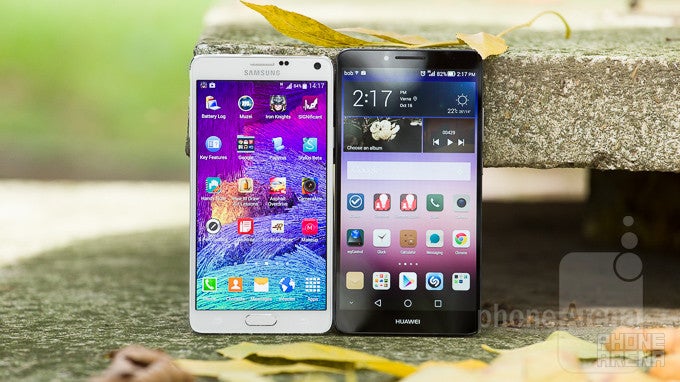
Introduction
The Galaxy Note series started the phablet craze in 2010, when the first-generation Note shocked us with its gigantic for the times, 5.3-inch display size, but fast forward to these days, and we’re seeing 5 to 5.2-inch devices becoming the norm for flagships, not phablets. Indeed, the definition of a phablet has changed, and today we’re looking at two devices of this new generation of even bigger phablets - the 5.7-inch Galaxy Note and the 6-inch Huawei Ascend Mate7.
Huawei’s Mate7 surprised us with its solid built quality and premium metal build when we took it for a review, but it’s also a well-rounded performer with one of the best fingerprint readers on the market.
The Galaxy Note 4, on the other hand, is one of the first of a new wave of Samsung devices that out style back in focus. The Note 4 features a metal frame, and a nice, faux-leather finish, plus it’s got the latest Snapdragon 805 silicon and an optically stabilized 16-megapixel shooter.
Can the Huawei Ascend Mate7, a device from a brand that is not particularly well known for its smartphones (at least in the Western hemisphere) actually outdo the Galaxy Note 4? We take a deeper look at the two to find out.
Design
Both the Note 4 and Ascend Mate7 feature premium designs, but the Mate7 is all-metal, while the Note 4 still has plastic back.
The Note 4 breaks is one of the first of the new wave of Samsung designs - those of a more premium feel, with a sturdy metal frame, and - still a plastic back cover - but one styled under faux-leather, and featuring a nice texture and feel.
The Huawei Ascend Mate7 in comparison sports a unibody metal construction, a single seamless piece of aluminum that exudes confidence and a feeling of stability. Speaking of pure aesthetic appearance - as subjective as it is - the Note 4 feels like a step forward in comparison.
The elephant in the room, however, is clearly size. We’re used to seeing big phones in the past few years, but it’s worth making it extra clear that these two are indeed very big devices. The Ascend Mate7 in particular with its 6-inch size that dwarfs the Note 4 is a phone that barely fits in some pockets, and that might be an issue for some people. Large devices like this pair come with plenty of benefits, but single-handed use is a struggle on both, and especially on the Ascend Mate7.
The Note 4 features the traditional for Samsung button layout with the physical home key with a fingerprint reader right below the screen, surrounded by two capacitive keys, one for multitasking and the back key. All other physical buttons are on the sides: the power/lock key is on the right, and the volume rocker - on the left. The keys are a bit too recessed, but also very clicky and comfortable to press. The Ascend Mate7 on its part features on-screen buttons that adopt the Android L triangle-square-circle look, but the neat thing is that Huawei allows you to add a fourth one (that opens the notification shade), as well as rearrange the places of the keys. On the right side, within a reaching distance, you have a lock key and a volume rocker. Both are made of metal, but the lock key has this rippled pattern that gives it a very stylish appearance, but adding to that is also that both are clicky and very comfortable. The Mate7 also features a fingerprint reader – a large one on its back, right below the camera. This feels like the right place for it - it’s right where your index finger stays when you hold the phone, and the scanning itself is extremely quick and very accurate. It works like the one on the iPhone, requiring just a touch and not a swipe as on the Note 4. Even better, you don't have to push any button when the phone is locked – just touch the sensor and the Mate7 will unlock.
Display
The Note 4 has the best AMOLED screen we’ve seen so far: a sharp, 5.7-inch Quad HD beauty with vibrant, accurate colors, while the Mate7 features an even larger 6” display with 1080p resolution and nice colors.
The Samsung Galaxy Note 4 comes with a 5.7-inch Super AMOLED display with a resolution of 1440 x 2560-pixels (Quad HD), while the Huawei Ascend Mate7 features an even larger, 6-inch screen of the IPS LCD kind, but a lower, 1080 x 1920-pixel resolution. With a pixel density of 515ppi, the Note 4 has the upper hand in terms of sharpness as the quality of the image looks as if straight out of a magazine. The Mate7, on the other hand, also has a fairly sharp screen with a pixel density of 367ppi, but pixel peepers would still notice an occasional jaggedness.
Switching to color fidelity, we’re impressed with what Samsung has done with the AMOLED screen of the Note 4. To see those accurate colors, you’d first need to go from the default ‘Adaptive’ screen mode to the color-accurate ‘Basic’ mode. In this mode, the white point is pinned down very close to the the reference 6500K value (so that whites are pure and not overly cold), and colors are very accurate. The color gamut in the default Basic mode is now also pleasingly within the industry reference sRGB color gamut. As usual with AMOLED screens, Samsung also includes other modes for those who prefer more ‘eye-popping’ colors that are not necessarily accurate. The Huawei Ascend Mate7, on the other hand, also features a very nice display, although not as good. Color temperature is just slightly on the cold side at 7111K, and greyscale accuracy with a delta of 5.16 is not ideal, but those are not huge deviations. Color accuracy is in fact very good, as all tones are within the sRGB gamut and saturations are right.
For outdoor viewing, Samsung manages a fairly good 468nits, and with reduced screen reflectance, the experience is nice and the display is legible even under the direct sun. The Mate7 is a bit brighter, but also picks up a bit more reflections, so readability is just a bit lower. Samsung manages 1 nit minimum brightness, making the screen very convenient for use at night (it’s not too bright), while the Mate7 could be uncomfortable for night birds.
Interface and Functionality
TouchWiz on the Note 4 has become brighter and has less clutter, all steps in the right direction. Huawei’s custom Android skin on the other hand often looks like a blatant iOS clone, but works fairly well.
Both the Note 4 and Mate7 feature Android 4.4 KitKat (the Note 4 has the slightly newer 4.4.4, while the Mate7 is on 4.4.2) on board, but there is a vast difference in the looks of the two platforms because of the different skins.
TouchWiz on the Note 4 appears in its most contemporary iteration, but you can still easily recognize it for its cartoonish icons and colorfulness. The refresh takes TouchWiz to new white-toned backgrounds, cleans it out of clutter, and gives it a more intuitive settings menu. The new set of fresh Quad HD wallpapers also looks great on the Note 4.
Huawei’s skin is called Emotion UI (EMUI, for short), and in the Mate7 it’s in version 3.0. With rounded-edge icons it has a bit of a retro style, and more mature, darker tonality, but you can also tweak this with a built-in theme manager. You also have a nice power usage tool, and an extreme power saving mode like on the Note 4.
Both being large devices, they feature modes that shrink down the screen and make the phone easier to use with a single hand.
Apart from that, basic functionality is well covered on both. The Note 4’s built-in keyboard has a fifth row of icons, and while buttons are a bit on the small side, it provides a fairly good typing experience. The Mate 7 features an XL sized keyboard and you can easily adjust to typing quickly on it.
Samsung’s TouchWiz is ahead of Huawei’s interface in a few areas. The first one is health tracking, an area where the Mate 7 does not offer any built-in app. The Note 4 with its updated S Health and new blood oximetry and UV radiation sensors in comparison brings something useful to the table.
Then, the signature S Pen functionality of the Note series comes in its most polished version on the Note 4. The important question for most users, however, is a simple one: can I use this to take notes as I usually do on paper? The answer is ‘not quite’. Despite its improved accuracy, handwriting on the S Pen is still accompanied with an annoying lag, and if you want to actually be able to read what you’ve written, you need to switch to a gargantuan font.
Finally, both the Note 4 and Mate 7 have a fingerprint sensor. On the Note 4, the fingerprint reader requires you to swipe the home key, while on the Mate 7 all it takes is a tap. The Note 4 fingerprint reading accuracy is an improvement over earlier Galaxies, but getting your finger on the home key is a bit hard with such a large device, and we feel that the rear-positioned finger scanner on the Mate 7 is a better fit for most situations. The Mate 7 is also more accurate and zippier.
Processor and Memory
The Snapdragon 805 is faster than Huawei’s HiSilicon chip: it’s nearly 25% faster in terms of CPU performance, and 50% better in graphics (and that’s on-screen performance).
The Galaxy Note 4 comes with the latest and most powerful Qualcomm SoC: the Snapdragon 805 (there is also an Exynos 5433 octa-core version for select markets). The Mate7, in comparison, runs on a Huawei-made HiSilicon Kirin 925 octa-core chip (with one additional small, ultra low power core) that you are likely not that familiar with.
In daily usage, both do a fine job handling Android mostly smoothly and fairly lag-free. IWhen we look in more detail, though, there is a slight, but noticeable difference in speed in favor of the Galaxy Note 4. It runs faster, something that’s particularly well noticeable when you scroll through lists and surf the web.
Looking at pure specifications, the Snapdragon 805 features a four Krait 450 CPU cores clocked at up to 2.7GHz, while the Mate7’s Kirin 925 comes with four performance-driven Cortex A15s running at up to 1.8GHz and four power-optimized Cortex A7s clocked at 1.3GHz for a total of eight cores. Going deeper in the specifications for the two chips, we see that the Snapdragon 805 is a 28nm chip built on the HPm process, similar in manufacturing to the Kirin 925 which is also a 28nm HPm affair. Both phones come with 3GB of RAM.
Benchmarks show a clear advantage for the Note 4 in terms of both CPU and GPU performance. The Note 4 has some 25% faster CPU and on-screen graphics tests show that the Mali T760 on the Samsung phablet performs around 50% better than the Mali T628 on the Mate7.
We should point out that - while most Western markets will get a Snapdragon 805-equipped Galaxy Note 4 - other markets, mostly in Asia, get an Exynos 5433-powered version of the phablet. Unlike the Snapdragon 805, the Exynos 5433 is a 64-bit chip that makes it future-proof and ensures compatibility with all the 64-bit optimizations coming with Android L and the ART runtime. The Exynos 5433 itself is an octa-core chip with four low-power Cortex A53 cores and four performance-driven Cortex A57s in a big.LITTLE configuration. The currently reviewed Snapdragon 805 and Kirin 925 are both 32-bit-only solutions that will not take full benefit from the improvements coming with the ART runtime in Android Lollipop.
The Galaxy Note 4 and Mate7 both feature 32GB of internal storage on board, double that of most rivals. You can also expand that via microSD cards of up to 128GB on both. Interestingly, while Huawei claims it has ‘the fastest eMMC flash memory’, we found the Note 4’s memory to outperform it in both sequential and random reads and writes.
Internet and Connectivity
You have a choice of two pre-installed browsers to surf the web on both the Galaxy Note 4 and the Huawei Ascend Mate7: a custom solution, as well as Google’s mobile Chrome. The Mate7’s custom browser comes with quite a lot of rough edges as zooming in and out happens with a stutter, and there were some other glitches. That is the reason why we feel that Chrome is the better choice if you want a smoother surfing experience on the Mate7. The Note 4, on the other hand, has a stock Samsung browser that works smoothly, comes with a rich variety of option and a nicely immersive full-screen option.
In terms of connectivity, you have 4G LTE on both, with theoretical peaks on both the Note 4 and Mate7 reaching 300Mbps for downloads (Category 6 LTE). Other connectivity options include Bluetooth 4.1 on the Note 4 versus 4.0 on the Mate7, dual-channel Wi-Fi on both, GPS, and NFC. The Note 4 also has an infra-red beamer with an accompanying app that you can use to remotely control electronics like your TV, while the Huawei phablet lacks this option.
Camera
The 16-megapixel camera on the Note 4 captures some of the best images we’ve seen on a smartphone: very detailed, and with nice colors, plus it can record 4K. The Mate7 is no slouch with good image quality, but it’s not on par.
The Samsung Galaxy Note 4 comes with a 16-megapixel rear camera that supports optical image stabilization (OIS), while Huawei’s Ascend Mate7 ships with a 13-megapixel main shooter with no optical stabilization.
Samsung is using a large, 1/2.6” camera sensor on the Note 4, while the Ascend Mate7 comes with nearly 17% smaller, 1/3.06” Sony IMX214 sensor. In terms of optics, the Samsung phablet has a 31mm f/2.2 lens, while the Huawei phone features a slightly wider and faster, 28mm f/2.0 lens.
Looking at the camera app, Samsung has kept on improving the experience and in the Note 4 it is simplified, with less clutter, instead focusing on showing only the most commonly used features important to the common user. Advanced manual settings are also available, it just takes a couple of extra taps to access them. Huawei’s camera interface, on the other hand, is the most blatant clone of Apple’s iOS camera app we’ve seen so far: it features the same large, red, round key, and you swipe to switch between different modes. Admittedly, though, this interface is very convenient to use.
When it comes to image quality, the Galaxy Note 4 is in a league of its own with outstanding amount of captured detail, pleasing colors, and a very dynamic look to shots. The Mate7, on the other hand, has images that are also of very good quality, with decent amount of detail, but in comparison with the Note 4 they look mushier, and somewhat lacking in dynamics.
Indoors, the Note 4 has a more evident advantage with its consistently sharp detail and realistic color tones, while the Mate 7 - even though overall good - was comparatively noisier, and more prone to shooting slightly blurry images. It also captured images with a noticeable warm (yellow-ish) tonality and slightly overblown colors. The Note 4 has a fairly strong single LED flash that is capable of lighting up a scene well enough, while the Mate 7’s flash is underpowered.
The Samsung phablet also has a 3.7-megapixel front camera, and it can capture some good-looking selfies, while the Mate 7’s 5-megapixel camera captures decent selfies, but of lower quality.
In terms of video, the Note 4 can recording 4K at 30 frames per second (fps), or 1080p at either 60 fps or 30 fps, while the Mate 7 can only shoot 1080p at 30 fps. 4K is a nice extra but it comes with some limitations - you can record only 5-minute long clips, for instance. Comparing apples to apples, or 1080p at 30fps, the Note 4 has the more pleasing colors with plentiful detail, while the Mate 7 looks a bit underexposed and tends to be slower with exposure compensation. Optical image stabilization on the Note 4 contributes to smoother footage.
Although it’s a win for the Galaxy S5 when it comes to snapping still images, we don’t particularly find one better at shooting video, since they record some sharp looking videos. In fact, they boast similar qualities – like smooth continuous auto-focus, decent exposure adjustment, and mostly clear audio. Heck, they both also offer 4K video recording.
Multimedia
TouchWiz adds a bit more flair for media with more functional video, music and gallery apps, while the Mate7 gets the job done with no frills.
The large displays on both - the 6” one on the Mate 7 and the 5.7” on the Note 4, are the biggest reason why media consumption is a pleasure both phablets. Both are also well equipped in terms of software and can easily chew videos with various encodings. The video app on the Note 4 shows your collection of videos with a nice live animation, giving you a quick glance of the content of each video. The Mate 7, on its part, has a simpler, no frills video gallery that is basically just a list of all the recordings on the phone internal storage.
For images, the Note 4 gallery is a nice experience that gives you dual-panel view for easier navigation and comes bundled in with rich image editing options, while the Mate 7’s gallery app is a very simple affair that either shows you your pictures as a list, or in a timeline.
The music player on the Note 4 is rich in settings and offers all the options, and fine tuning that you might want, while the Mate7 has a simpler, but visually fairly clean and nice looking music player. The single speaker of the Galaxy Note 4 comes with a decent amount of volume output, but it lacks sorely in depth, contributing to its rather thin sound quality. The Mate7 is not among the best we’ve heard either - it has a bit more depth, but is lacking in loudness. Both also have their speakers on their back, meaning that if you lay them on it, sound appears quieter and muffled.
Call Quality
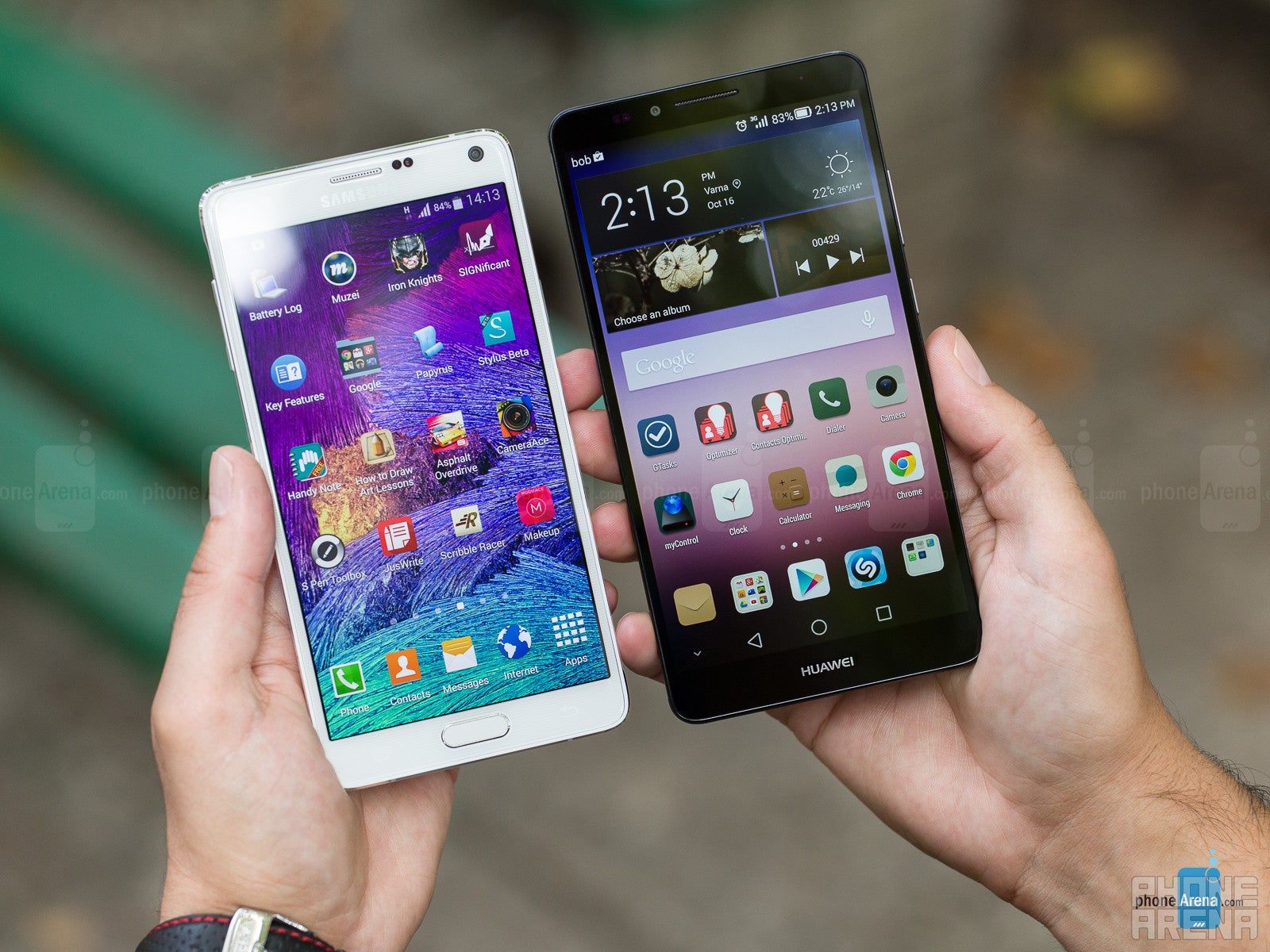
The same cannot be said about the Mate7. It features a quieter than we’d like earpiece and incoming voices sound a bit robotized, with a digital undertone. On the other end of the line, sound is a bit better but still not perfect in terms of clarity.
Battery
The large size of phablets like the Galaxy Note 4 and the Mate7 allows manufacturers to bundle them in with gigantic batteries: the Note 4 has a 3220mAh cell, while the Mate7 ups the ante to the whopping 4100mAh juice pack.
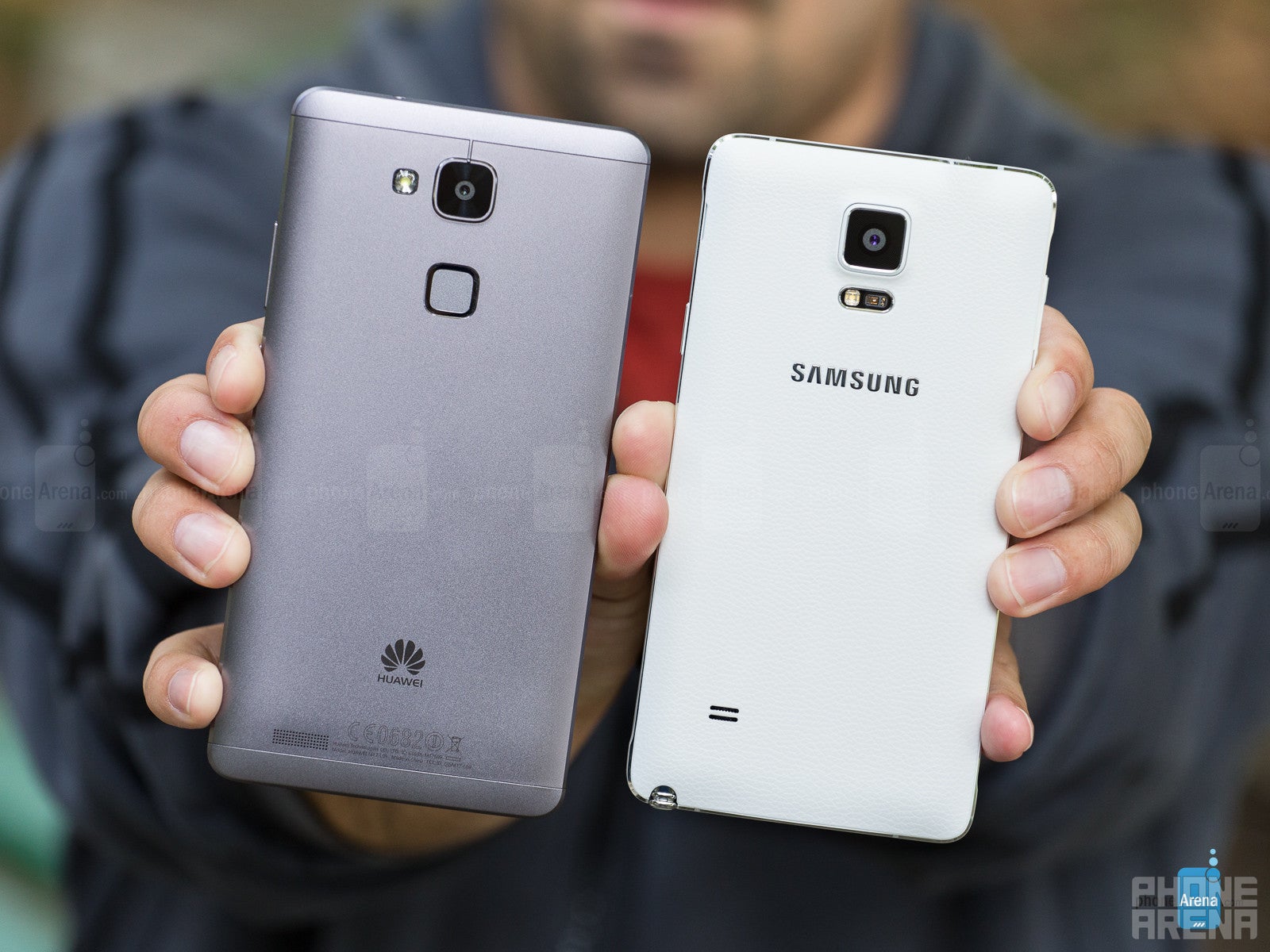
Samsung has also been one of the first companies to include a new, ultra power saving mode for its Galaxy series, a mode which turns the screen to black and white (a big battery saver for AMOLED displays that are capable of just shutting down individual pixels to achieve pitch black without using energy), and caps the processor. The Note 4 is no exception, as it comes with the UPSM on board. Huawei also has its own ultra power saving mode that only keeps basic call and messaging functions, but while on Samsung you can still use some apps like the browser, on the Mate7, Ultra power saving basically turns your phone into a phone and messaging machine only, with no connection to the Internet.
Finally, while the Note 4 does feature a user-removable battery, the Mate 7 does not come with such an option.
Conclusion
The Samsung Galaxy Note 4 and the Huawei Ascend Mate7 are two of the best options on the market right now, if you’re looking for a smartphone with a large screen. With this in mind, the 6-inch Mate7 may be a bit too steep of a form factor for some, with its wide screen that is harder to operate with one hand, so before looking into the specs, we do recommend you considering the size difference with these two.
With the Galaxy Note 4, Samsung has made some big strides forward - the metal frame, new elegant design, and the simplified TouchWiz are all steps in the right direction. The Mate7, on its part, is even better in terms of style and build quality is solid with its sturdy metal back, but the software often feels like a blatant clone of iOS.
Then, we’re in love with the 16-megapixel OIS camera on the Note 4, a shooter capable of capturing some of the best images of any smartphone, while the Mate7 is good but not that great. The Snapdragon 805 chip is also a level above Huawei’s own HiSilicon chip - the Qualcomm chip is faster in terms of both CPU and GPU.
The Mate7 does have a more alluring price at around $600 for a basic model with 16GB of storage and 2GB of RAM, but the 32GB storage/3GB RAM model that is a more direct rival to the Samsung phablet comes in at $700, which is not that far off the $800 off-contract asking price of the Note 4. All in all, if you want the faster and more powerful device, the Note 4 seems like the better choice, but if you don’t mind sacrificing a bit in terms of performance, and if you want the larger screen, the Mate7 is not a bad option either.
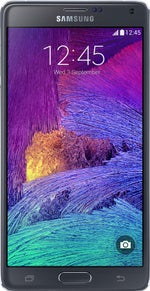










![T-Mobile users can get iPhone 16 for the price of a budget phone (no new line) [UPDATED]](https://m-cdn.phonearena.com/images/article/167601-wide-two_350/T-Mobile-users-can-get-iPhone-16-for-the-price-of-a-budget-phone-no-new-line-UPDATED.jpg)


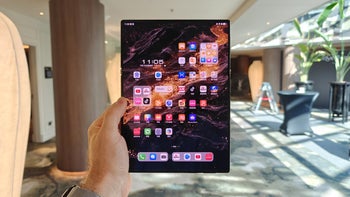


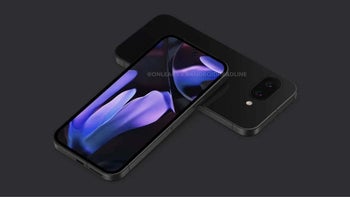
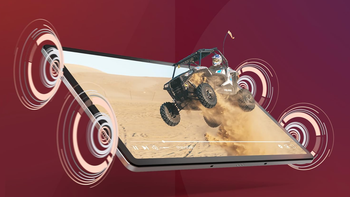

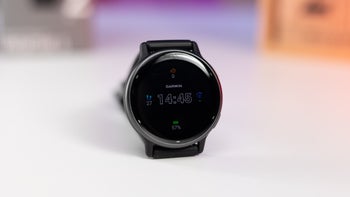
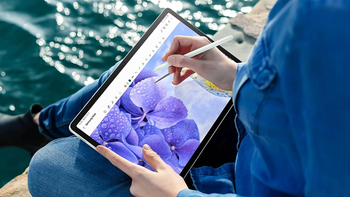
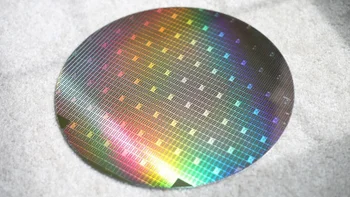






Things that are NOT allowed: